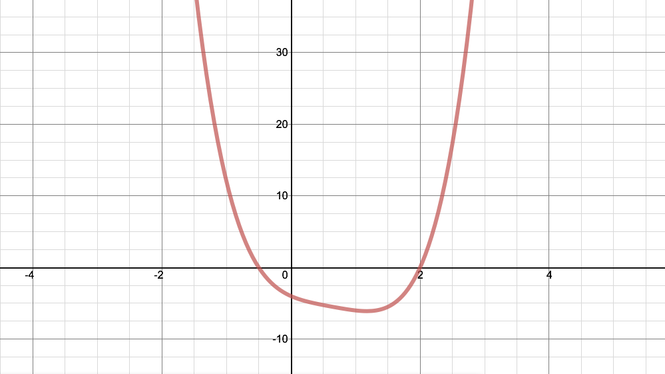The expression \[2x^4+ax^3+bx^2-4x-4\] where \(a\) and \(b\) are constants, is denoted by \(f(x)\). Given that \(f\left(-\dfrac{1}{2}\right)=0\) and \(f(2)=0\), find the values of \(a\) and \(b\).
We now have two simultaneous equations in \(a\) and \(b\). If we add twice the first to the second, to eliminate \(a\), we see that \(5b = 25\) and so \(b = 5\).
We can then use either equation to find that \(a = -5\).
With these values for \(a\) and \(b\)
- express \(f(x)\) as the product of three algebraic factors, and hence show that the equation \(f(x)=0\) has only two real roots;
Since \(f\left(-\frac{1}{2}\right)=0\) and \(f(2)=0\) we know that \(2x+1\) and \(x-2\) are two factors of \(f(x)\).
So \[f(x)=2x^4 - 5x^3 + 5x^2 - 4x - 4 =(2x+1)(x-2)g(x) = (2x^2 - 3x -2)g(x),\] where \(g(x)\) is a quadratic polynomial. By inspection, we can see that \(g(x)=x^2-x+2\).
Therefore we have \[f(x)=(2x+1)(x-2)(x^2-x+2).\]
To show that \(f(x)\) only has two real roots we need to show that \(g(x)=x^2-x+2\) has no real roots.
The discriminant of \(g(x)\) is \(1 - 4 \times 2 = -7\), and since this is negative, we see that \(g(x)\) has no real roots.
So, we can conclude that \(f(x)\) has exactly two real roots, which are \(x=-\dfrac{1}{2}\) and \(x=2\).
- find the set of values of \(x\) for which \(f(x)>0\).
If we sketch the graph of \(f(x)\), we’ll clearly see the regions for which \(f(x)>0\). We know that there are only two real roots, and we observe that the \(y\)-intercept is \(-4\).
So the graph is

From this, we can see that the values of \(x\) for which \(f(x)>0\) are \(x<-\dfrac{1}{2}\) and \(x>2\).

